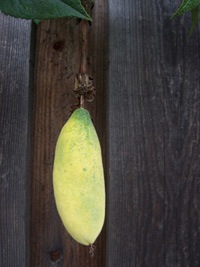- Trace chemicals in Chinese dog bones from 7-8K years ago suggest a diet high in millet, and therefore its cultivation.
- Maize origins pushed back and down.
- A new cowpea system, including faster varieties, being tried out in Niger.
- It’s spring, and Italians’ thoughts starting to turn to eating weeds.
- “…his 3 wives and 20 children depend on the water melon business as means of livelihood.”
South helping North
Don’t despair if you haven’t much room — you can still get produce from plants grown in old tins and tubs on window sills or balconies.
That’s Faustino Reyes Matute from San Marcos, Honduras. Only one of the many subsistence farmers that are providing advice to allotment owners and others would-be farmers in Britain, people “who have turned to growing their own fruit and veg as the nation tightens its purse strings in the recession.” The Catholic charity Progressio is behind the great idea.
Aid Tree Aid
A BBC story alerted me yesterday to the existence of Tree Aid:
TREE AID was established as a charity in 1987 by a group of foresters in response to the famine in Africa, brought to public attention by Band Aid and Live Aid.
They wanted to provide a long term solution once the emergency relief efforts ended. They believed that trees could significantly reduce the vulnerability of communities in rural Africa’s drylands to drought and famine in the future.
Our current strategy expands on the original concept, focusing on forest management and income, food and medicines from trees.
I like their Cake Taste initiative, and their Tree of the Month feature. Seems very worthy. And it’s easy to donate online, should you feel so inclined.
Do you know this fruit?
 The folks over at The Human Flower Project are trying to identify this fruit, which apparently can be found in abundance in Oakland, California. They think they’ve pinned it down to Passiflora mollissima, but maybe you know better. I grew P. mollissima once, in an unheated greenhouse, and although it flowered well enough it didn’t set fruit. So although the flowers look familiar, the fruit remains a mystery. One of the reasons I wanted to grow it was to do this:
The folks over at The Human Flower Project are trying to identify this fruit, which apparently can be found in abundance in Oakland, California. They think they’ve pinned it down to Passiflora mollissima, but maybe you know better. I grew P. mollissima once, in an unheated greenhouse, and although it flowered well enough it didn’t set fruit. So although the flowers look familiar, the fruit remains a mystery. One of the reasons I wanted to grow it was to do this:
“The pulp is eaten out-of-hand or is strained for its juice, which is not consumed alone but employed in refreshing mixed cold beverages. In Bolivia, the juice, combined with aguardiente and sugar, is served as a pre-dinner cocktail. Colombians strain out the seeds and serve the pulp with milk and sugar, or use it in gelatin desserts. In Ecuador, the pulp is made into ice cream.â€
Those treats remain a fond hope. I had a quick look to see whether the juice or pulp might be available commercially in Europe, but couldn’t find anything. Is it?
Nibbles: Venezuela, Bangladesh, Climate change, Geographic indications, Dried herbs, Maize, Cydonia, Snakes, Hawaii, Pinot passion
- “For some, eating out at an arepa place is turning into a luxury.” Go Chavez!
- “Two farmer families live adjacent with one another. One has a good quality mango tree and other one has same as a jackfruit tree.” Discuss.
- “Ex situ conservation in genebanks must expand dramatically.”
- “…the question concerns how [geographic indication] could help develop commercial food crop growing, fix agricultural and food know-how, ensure food security in rural areas, and alleviate poverty.” That indeed is the question.
- “Il profumo dell’origano di Sicilia rimane integro sino allo sbriciolamento.” I would hope so!
- Purple maize used to make dyes. What’s wrong with just eating the damn stuff?
- “…it was probably a quince and not an apple or Cheeto that Adam tempted Eve with.”
- Farming snakes in Thailand.
- “Instead of being a source of health and well-being for the land and people, the American system of industrial agriculture has become a source of problematic food and even fear.” Via.
- “Pinot Noir first came to America … in the middle years of the 19th century.”